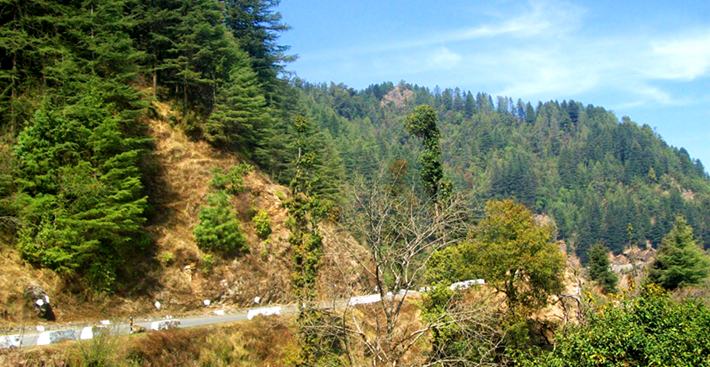Including the poor into the formal financial system has been hard despite numerous and sustained efforts. The difficulty in achieving inclusion attains a whole new meaning in hills and mountainous regions where populations are sparse and connectivity is extremely low. My realization of this fact achieved some maturity after a recent 5th birthday celebration meeting of the Center for Micro Finance (CMF) research.
After a lot of research and some excellent recommendation from Anupama Joshi (CEO, Sahastradhara KGFS), Lakshmi Krishnan and Deeptha Umapathy (Program Heads at CMF) zeroed in on Kanatal Resorts, Uttarakhand as the site for CMFs most recent research associate-birthday bash meeting. Located amidst the picturesque Tehri-Garwhal hills, Kanatal is a site for sore eyes and a panacea for the tired soul and body.

The drive up to Kanatal
After a half day of deliberations and updates on various research projects that CMF is leading across the country, Anupama Joshi closed the first day meeting with a brief presentation on Sahastradhara KGFS (SKGFS) – entity aimed at underserved rural areas of Uttarakhand. Ms. Joshi’s presentation highlighted some of the challenges faced in serving the hills, namely –
- Due to the extremely low population densities, SKGFS has had to relax its service radius and population number criterion from other KGFS ventures in the plains (DKGFS and PKGFS).
- Due to the hilly terrain and larger distances between the service provider and the served, technology is much more relevant in attracting and retaining clients. SKGFS has evolved a financial delivery model that is hybrid of branch-based and doorstep delivery.
- Compared to the plains, women’s participation is extremely low (probably due to a potent combination of travel difficulty and household/farm-related chores).
- Credit culture is low, and traditional JLGs do not work well. Financial trust among villagers who are even related to each other is not high.

SKGFS and CMF staff at Jadipani branch
To help understand these issues better, SKGFS invited CMF to its Jadipani branch the following day. After a brief introduction to operations, CMFers split into groups of 5-8 and ventured into nearby villages to hold brief discussions with local households. Each CMF team was ably led by an SKGFS wealth manager who played the role of a guide and host to perfection. CMFers huffed and puffed along the hilly tracks very quickly humbled by the terrain, further adding to the appreciation of the work that wealth managers and SKGFS is doing.

Projjal talking to Mr. Govindram and his wife.
The different CMF teams interviewed about 16 households in total. Post-visit here are some key observations from our group (Stuti, Deepti, Shreyas, Srikumar and Sushanta) –
Socio-economic conditions and access to finance:
- The sanitation conditions and quality of the house structures were much better in Jadipani than much of India. Anecdotally, it seems that people invest a lot in making their houses better.
- Most of the households we visited had some members in army which had helped them keep a decent standard of living because of the pensions provided by the Government. We noticed that pensions were the bulk of the income for many households.
- Most households had access to bank accounts (according to the Branch Manager of Uttarakhand Grameen Bank, 700 households in a radius of 5kms had bank accounts. He estimated that the total population in the radius to be 2000). 70% of these accounts however were NREGA-disbursement accounts, with voluntarily created savings-accounts in the minority.
- Savings is a space where private players can enter as the living standard in the region suggests that significant savings can be mobilized. Villagers currently invest on their house and in jewelry.
- Almost all households had younger members who had left the village for better livelihood. The younger members were remitting money back home either through the post office or through acquaintances. We suggest that villagers’ interest in efficient remittance services be explored.
- Agriculture is a primary source of work, although contribution to income is low due to poor rainfall in non-monsoon seasons over the last three years. This is unfortunate and easily remediable because the region still receives rainfall in the monsoon months. Loans for water-harvest tanks can help push up agricultural productivity significantly. A lot of the landscape is barren due to deforestation, thus loans for plantation can potentially help increase incomes and improve local ecosystem as well. Also the region grows apples and potatoes as cash crops, however there are a few insurance companies that provide cover for these crops. Households generally seemed to be interested in this kind of financial service but due to geographical constraints list of service getters remains limited to the ones living close to the market/road.
- As mentioned in Anupama Joshi’s presentation, women seem to participate very actively in economic roles, but their say in financial decisions is low. Reasons for this low participation maybe a combination of culture and hard terrain. If hard terrain were the principal reason (which I suspect), technology and service at the doorstep or at the farm can improve the situation greatly. On a related note, could the fact that most JLGs are male groups be a cause for JLG under performance? Would carefully nurtured women’s groups perform better?
The Jadipani visit has thrown up many research and operational questions that need to be answered quickly, for financial inclusion in the hills to be a reality. Hopefully the initial steps that SKGFS has taken on the service delivery side and research studies that CMF is starting in Uttarakhand, will soon shed light on straightforward questions that need very innovative answers.
—
Ajaykumar Tannirkulam, CMF, contributed this post. Photo credit: Projjal Saha, Sushmita Meka and Srikumar



5 Responses
Congratulations…its a tough area to work and we appreciate SKGFS efforts.
Great observations captured Ajay. May be the sparsity of the population caused by difficult terrain is leading into less socialization of women amongst them, and that is the reason for lower interactions and less human relationship and trust in the area. That primarily is also feeding into less confidence in woman to participate in family financial decision making inspite of being income contributor.
I definitely see a good role of social networking intervention especially between the women group. And that should not be initiated from JLG or any financial layer but more from social and cultural aspects to retain their interest.
Congratulations to the CMF team for making this as applied research. All the best.
Thanks Ajay and team for very valuable recommendations. Our big task in the coming year will be to push the envelope on the operating model to bring services closer to each household and develop a product suite (commercial vehicle loans for transport from plains to hill, high value crop finance for the cash crops grown there, domestic remittance and so on) that responds to the needs of the region. We look forward to your continued support;
I beg to differ on the sparse population being cause of women not socializing, contrary to that they work in groups on feild shifting from one persons land to the other. Social bonding between them is amazing and to a large extend have social decision powers but when it comes to finance its the man who make all decisions.
Also on point of remitences if you see a large number of inflow is from family member being in army which gets channeled through SBI or P&T.Though we have a scope to trap in places like delhi, mumbai and chandigarh were a large number have gone to work in " Hotel Industry", basically majority working as cooks and waiters.It is said that uttrakhand runs the Delhi's Hospitality Industry.
Thanks CMF for appreciating our work,We shall endevour to have sustainable Hill Model.